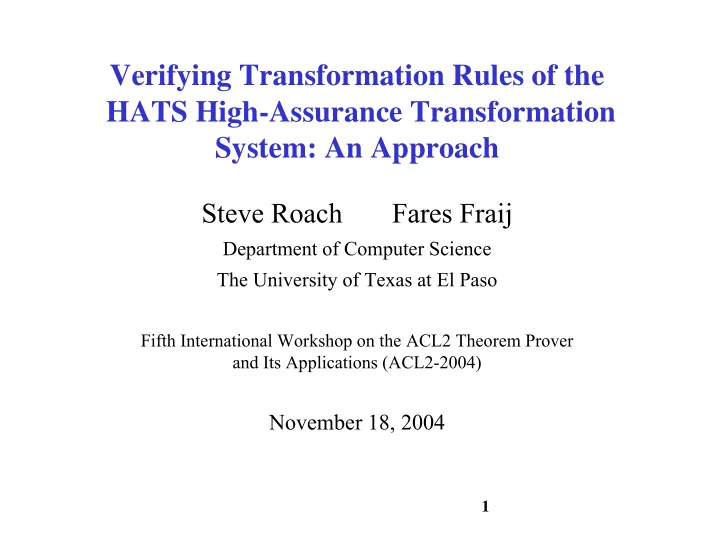

Verifying Transformation Rules of the HATS High-Assurance Transformation System: An Approach Steve Roach Fares Fraij Department of Computer Science The University of Texas at El Paso Fifth International Workshop on the ACL2 Theorem Prover and Its Applications (ACL2-2004) November 18, 2004 1
Goal Develop models and techniques using ACL2 to prove the correctness of HATS transformation rules and apply them to a high-consequence system 2
Formal Approaches for Software Assurance • Transformation-Oriented Programming (TOP) Incremental refinement of formal specifications to implementations – Correctness by construction – Examples: HATS , Maude, ELAN, Stratego, and ASF+SDF • Automated theorem provers Model computing systems and their desired properties in the language of the of the theorem prover and prove the correctness of these properties using inference rules, axioms, and theorems – Correctness by verification – Examples: ACL2 , HOL, PVS, Isabelle 3
HATS Goals • Create a language-independent program transformation system • Perform program transformation in a provably correct fashion • Provide framework for experimenting with transformation techniques 4
HATS High-Level Overview Input Transformation • Transforms input program in Language programs written in specification Program abstract languages to language output programs in concrete languages • Transformation language HATS program (TLP) consists of Engine sequence of transformation rules and a control strategy Output program in implementation language 5
HATS Transformation Language Program Transformation rules Combinators Control strategies • General form Control the application of transformation rules to • Types: LHS → RHS if C the input file – Seq (;) • Two types of • Types: – Left-biased (<+) transformation rules – Once – Right-biased (+>) – Fix – First-Order – Transient – High-Order – Hide 6
Example: Once VS. Fix Given the following table, T, the goal is To resolve the pointers in the table T, the to resolve the pointers in the second following first-order transformation rules column to their respective string values are needed: T = ((1 “Hello”) TR-1.0 = (x 1) (x “Hello) (2 “World”) TR-1.1 = (x 2) (x “World”) (3 2) TR-1.2 = (x 3) (x 2) (4 3)) TR-1.3 = (x 4) (x 3) 7
Example: Once VS. Fix Rule-list TR-1.0 = (x 1) (x “Hello) TR-1.1 = (x 2) (x “World”) TR-1.2 = (x 3) (x 2) TR-1.3 = (x 4) (x 3) Rule-List Rule-List NEW-T = ((1 “Hello”) FINAL-T = ((1 “Hello”) T = ((1 “Hello”) (2 “World”) (2 “World”) (2 “World”) Result Result (3 2) (3 “World”) (3 “World”) Once Once (4 3)) (4 “World”) ) (4 2)) Rule-List FINAL-T = ((1 “Hello”) T = ((1 “Hello”) (2 “World”) Result (2 “World”) (3 2) (3 “World”) Fix 8 (4 3)) (4 “World”))
Verification Challenge How do we know transformations are correct? 9
High-Consequence Application: Sandia Secure Processor (SSP) Java Source • A general-purpose class class class computational Commercial Java Compiler infrastructure suitable for use in high-consequence classfile classfile classfile embedded systems • A simplified Java The SSP classloader processor designed to be (static) small and analyzable ≡ Intermediate JVM Form • Closed system (ROM image) runtime (dynamic) 10
SSP-classloader and HATS C C F : C lassfile • HATS is used to implement the classloader SSP-classloader (Static ) • Functionality of the SSP- TLP 1 The SSP The SSP classloader is decomposed into C IF1 classloader classloader five canonical forms (Static ) TLP 2 (static ) • TLP 1 : index resolution C IF2 Intermediate Intermediate Intermediate • TLP 2 : static fields address Form Form Form TLP 3 calculation (R O M image) (R O M image) (R O M image) • TLP 3 : instance field offset C IF3 runtime runtime runtime calculation (dynamic) (dynamic) (dynamic) TLP 4 • TLP 4 : method table C IF4 construction TLP 5 • TLP 5 : inter-class absolute address and offset address distribution C R OM (ROM im age) 11
Methodology • Model the HATS TLP 1 in ACL2 – Modeling the control strategies and the combinators, model TLP1 – Defining semantic function, S 0 • Prove that the application of the transformation rules preserves the semantics 12
Methodology • Model the behavior of TLP 1 fix-strategy (C CF , rule-list) – Applies the rule-list to C CF exhaustively • Construct a semantic function S 0 for TLP 1 get-constant (n C CF ) – Chases a pointer n down in a table C CF • Main conjecture: ∀ (C CF ) S 0 (model TLP1 (C CF )) = S 0 (C CF ) , i.e., ∀ (C CF ), get-constant (n, (fix-strategy (C CF , rule-list))) = 13 get-constant (n C CF )
Simplified ACL2 Model of TLP 1 Put-in-place (new-node, classfile) apply-rule-to-node (rule, i, classfile) apply-rule-list-to-node (rule-list, i ,classfile) once-strategy (rule-list, tail, classsfile) fix-strategy1 (rule-list, classfile) generate-rules (classfile) fix-strategy (classfile) 14
Verification • Proof of termination of fix-staregy1 • Proof of the main conjecture 15
Proof of Termination (defthm sum-addr-once-strategy-strictly-< (implies (and (well-formed-classfilep classfile) (some-matchp rule-list tail classfile)) (< (sum-addr-to-resolve (once-strategy rule-list tail classfile)) (sum-addr-to-resolve classfile)))) 16
Proof of The Main Conjecture ∀ (C CF ) (get-constant n (fix-strategy C CF )) = (get-constant n C CF ))) • Main conjecture in ACL2 (defthm get-constant-n-fix-strategy1 (implies (well-formed-classfilep classfile) (equal (get-constant n (fix-strategy1 rule-list classfile)) (get-constant n classfile)))) 17
Recommend
More recommend